 Melanie Erspamer studies English Literature and Philosophy at the University of Edinburgh. She is half-Italian and half-American and has lived most of her life near Boston. Her work has been published in The Purple Breakfast Review, Nomad Magazine and Unknown Magazine, and her one-act play was performed at the University of Edinburgh. With her sister, she also has been running an anonymous literary magazine based in bathroom stalls, called Bathruminations.
Melanie Erspamer studies English Literature and Philosophy at the University of Edinburgh. She is half-Italian and half-American and has lived most of her life near Boston. Her work has been published in The Purple Breakfast Review, Nomad Magazine and Unknown Magazine, and her one-act play was performed at the University of Edinburgh. With her sister, she also has been running an anonymous literary magazine based in bathroom stalls, called Bathruminations.
NEVER ANYONE BUT YOU, a novel by Rupert Thomson, reviewed by Melanie Erspamer
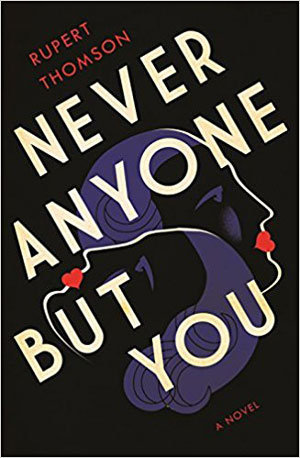
NEVER ANYONE BUT YOU by Rupert Thomson Other Press, 345 pages reviewed by Melanie Erspamer With quiet skill and rich description, Rupert Thomson strings the lives of two eclectic lovers through the tumultuous history of Paris and the Channel Islands during and between the two World Wars. In the early 20th century in Nantes, Suzanne Malherbe met Lucie Schwob, a precocious but disturbed girl from a family of wealthy Jewish intellectuals. Immediately, Suzanne felt both mental and physical attraction to her, as Thomson writes, in this novel based on their lives: “some moments are so dazzling that they obliterate everything that came before.” They swiftly became friends. Never Anyone But You is the story of the life-long relationship this early friendship spawned, a relationship that, in the novel, seems never to lose its sharpness, its occasionally doubt-inducing sincerity, its ultimately life-affirming completeness. The book reveals as it lyrically tumbles through almost eighty years the way Suzanne and Lucie’s relationship was almost self-sufficient, able to shine by itself in a large house in Jersey without the need of much outside sustenance. “Never anyone but you” morphs almost into an idealized never anything but you. Suzanne and Lucie eventually moved to ...
NOTHING and DOTING, two novels by Henry Green, reviewed by Melanie Erspamer
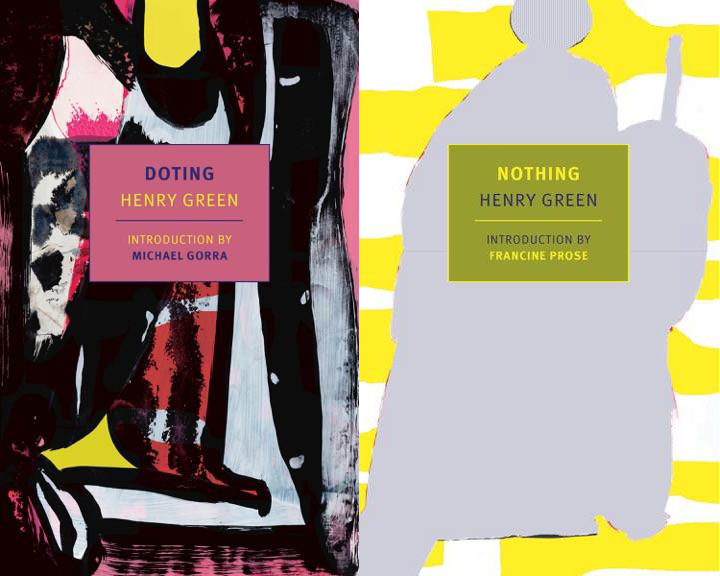
NOTHING and DOTING two novels by Henry Green New York Review Books, 183 and 190 pages reviewed by Melanie Erspamer In Nothing, Henry Green is as self-aware as it gets, poking fun not only at his characters but at the premise of the book (knowing full well, I imagine, the delightful difficulty readers would encounter in explaining to their friends that they are reading “nothing”). “What did you do?” one character, Liz, demands of her older boyfriend, John Pomfret, as he discusses afternoons from his youth. “‘Why nothing of course,’ Mr. Pomfret crie[s]. ‘That is the whole beauty of us, we never can seem to do anything.’” Precisely. In Henry Green’s two last novels, Nothing and Doting, the “doing” is severely limited in favor of a writing style built almost entirely on dialogue. The exposition seems to function largely as stage directions, basic information for the reader, though occasionally Green does display a bit of the modernist style he is most famous for: It was wet then, did she remember he was saying, so unlike this he said, and turned his face to the dazzle of window, it had been dark with sad tears on the panes and streets ...
A WORKING WOMAN, a novel by Elvira Navarro, reviewed by Melanie Erspamer
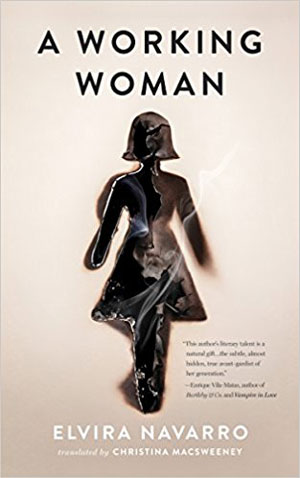
A WORKING WOMAN by Elvira Navarro translated by Christina MacSweeney Two Lines Press, 189 pages reviewed by Melanie Erspamer “She wanted […] the location of her madness to be now the location of her art.” This is how the narrator of The Working Woman analyzes her roommate, but the same can be said of the narrator herself, and perhaps as well of the only figure in this postmodernist novel who actually “speaks:” the author, Elvira Navarro. The text becomes the conjunction of madness and art, which share one abstract and yet delineated “location,” madness needing expression through art, or art uniquely poised to express madness. I may have gotten ahead of myself; I haven’t introduced the novel properly. The work itself forfeits any loyalty to structure or linearity in favor of a narrative that prioritizes aesthetic backways and internality. It is a quiet, decisively not flashy postmodernist masterpiece, a book packed with subtlety and originality that still manages to give insight into contemporary society. Navarro has received various honors in Spain and around the world, including the IV Premia Tormenta for best new author and inclusion on Granta’s list of the 22 best writers in the Spanish language under 35-years-old ...
THE MONEY CULT by Chris Lehmann reviewed by Melanie Erspamer
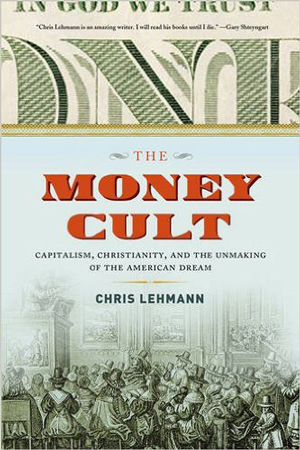
THE MONEY CULT by Chris Lehmann Melville House, 376 pages reviewed by Melanie Erspamer “The number of poor who are to be sympathized with is very small [...] let us remember there is not a poor person in the United States who was not made poor by his own shortcomings, or by the shortcomings of someone else. It is all wrong to be poor, anyhow.” If this sounds like something Ted Cruz would say, then perhaps the author Chris Lehmann is on to something: these are words spoken by Baptist minister Russell Conwell near the end of the nineteenth century Lehmann quotes in his history of America’s wealth gospel, The Money Cult. Conwell was speaking to a crowd of people come to witness his preaching and assured them that there were “acres of diamonds” literally within their reach, if only they were deserving of God’s grace. (Conwell is the founder of Temple University, named for his Baptist temple.) It seems strange at first that a religion whose scripture teaches that “it is easier for a camel to go through the eye of a needle than for a rich man to enter the kingdom of God” should become—in its ...
THE YOUNG BRIDE, a novel by Alessandro Baricco, reviewed by Melanie Erspamer

THE YOUNG BRIDE by Alessandro Baricco translated by Ann Goldstein Europa Editions, 174 pages reviewed by Melanie Erspamer I am not sure I liked this book—since after all, I am currently on a plane flying back to Barcelona from Berlin (many of my syllogisms are in fact inscrutable). That parenthetical gives a taste of an oft-repeated statement in The Young Bride, and the first sentence reveals the structure, or at least idea of structure, underlying the novel: two separate things, true or valid in themselves, but placed in a relationship with no logical basis. The author of the novel, Alessandro Baricco, a popular Italian writer, director and performer, suggests that a world based around logic and sense ultimately will stifle us. It is in fact, what the narrator of the main story, the “author” (easy to conflate with Baricco, though we shouldn’t), desires to escape from. He does so by running to fantasy: a place gleefully empty of logic or sense. However this is not to suggest that it is a place of chaos or anarchy—in fact quite the opposite. Fantasy rather offers refuge from the chaos of everyday life through its own simple and overriding logic: ...
THE BIRDS, a novel by Tarjei Vesaas, reviewed by Melanie Erspamer
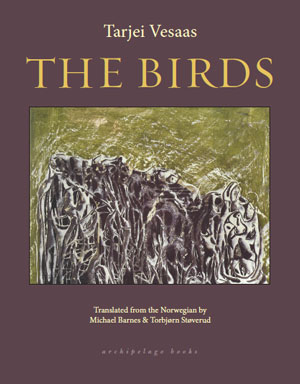
THE BIRDS by Tarjei Vesaas translated by Michael Barnes & Torbjørn Støverud Archipelago Books, 301 pages reviewed by Melanie Erspamer Had The Birds been written from the perspective of another character other than Mattis, a dim-witted near forty-year old, it probably would have had a different title—The Lumberjack, maybe, or some other word that references one of the major events in the novel. But that’s the point: the perspective, usually in third person but sometimes slipping into first person, is Mattis’ and thus the story is his. Although often the characters in a book share the same events, they do not share the same story; for that, as Norwegian author Tarjei Vesaas shows brilliantly in this moving novel, depends on the way we see things, on the importance we give to those events we share. For Mattis, the most important events in the novel concern the birds. Mattis and Hege are brother and sister living in a solitary house by a lake in a remote village in Norway. Hege knits sweaters to support the both of them, while Mattis has never been successful in finding work. Why? He’s not one of "the clever ones." This vague description is all the ...
